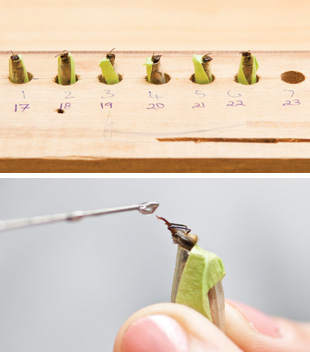Microbiologist Steve Chambers wanted to know what tuberculosis (TB) smells like. So the University of Otago, New Zealand, researcher cultured Mycobacterium tuberculosis, the bacterium responsible for the disease, and then fitted absorbent fiber tubes into the headspace of the culture vials to capture the volatile odors that the bacteria emitted. He analyzed the extracts using a gas chromatographer/mass spectrometer, and found four compounds that appeared to be made by M. tuberculosis. Chambers reasoned that if the breath of TB patients were also laced with these compounds, he might have found an alternate method for detecting the disease. Indeed, when he tested the breath of patients, he detected one of his four volatiles, methyl nicotinate (exhaled as nicotinic acid by patients)—a key note in the perfume of tuberculosis.
When one of Chambers’s colleagues caught wind of the discovery, he put him in touch with fellow New Zealand scientist Max...
To find out if insects could smell the methyl nicotinate released by TB bacteria, Suckling started with a moth. He attached electrodes to its antennae and measured action potentials in sensory neurons. Although the moth appeared able to detect methyl nicotinate, the test was indiscriminate, with the nerves in the moth’s antennae firing at many odors.

Undeterred, Suckling remembered reading about a company in the United Kingdom called Inscentinel that was developing a technology using honeybees to detect explosives in airports. The company had successfully trained bees to detect the smell of bomb materials. Using Pavlovian conditioning, bee trainers at Inscentinel conditioned the bees to exhibit a reflex—sticking out their tongues, or proboscises—when they smelled a volatile compound indicative of explosives. During the training period the desired behavior was rewarded with food. The bees were then inserted into a specially designed container that observed their faces with a miniature camera or infrared light-emitting diode beam and movement-recognition software.
If he could train a honeybee to stick out its proboscis at the scent of tuberculosis, Suckling reasoned, perhaps he and Chambers could use the insect to identify TB patients in countries where the disease is common, and where cheap, easy-to-use diagnostic methods are in high demand.
With the help of summer student Rachael Sagar, Suckling set out to train a few honeybees from the Institute’s hive. While trying to avoid painful stings, they enticed individual bees to crawl inside a 1 mL plastic pipette that had its tip cut off, so that only the bee’s head poked out. Secure from the threat of being stung, they puffed TB volatiles at the bee, using a Pasteur pipette containing filter paper infused with one of three characteristic components of the smell of M. tuberculosis. Every time the bee correctly stuck out its proboscis in response, it was rewarded with food. “It was pretty easy to train them,” says Suckling. Four exposures to the smell was all it took for the bees to reliably stick out their tongues. They proved able to detect two of the compounds (though not nicotinic acid) at very low concentrations.
Suckling and Sagar published their work online last May (Tuberculosis, 91:327-28, 2011), and together with Chambers have since been looking for grant funding for studies that will test the bees’ ability to detect tuberculosis infections in humans. If successful, the approach could have applications beyond TB, says Chambers. A number of diseases release volatiles that could be diagnostic, such as those emitted by the fungus Aspergillus and by cancer patients, which some investigators are trying to detect with the help of dogs. Dogs are another option, concedes Suckling, but “anything dogs can do, bees can do cheaper.” While Chambers and Suckling plan to collaborate, Chambers is happy that Suckling is doing the bee work. “I don’t especially like bees,” he says. “They sting people, and I’m allergic.”
But not everyone is convinced that bees can overcome the regulatory hurdles of creating a reproducible diagnostic method for use in developing nations. “Globally, there’s been a tremendous roadblock” to developing easy, cheap, accurate TB diagnostics, says Elizabeth Talbot, a professor of infectious disease at Dartmouth Medical School, who has spent time in Botswana as part of the Centers for Disease Control and Prevention’s global tuberculosis control initiative. “It’s hard to imagine a technology based on a living creature requiring human training” being reliable in areas where quality control could not be assured.
See more of the experimental setup.
[gallery]
Interested in reading more?




